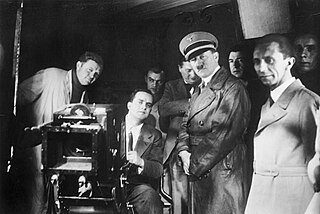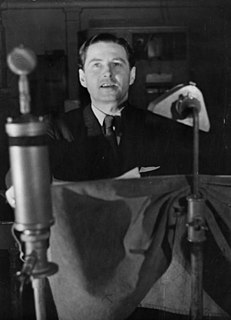Related Research Articles

Nazi Germany, officially known as the German Reich from 1933 until 1943, and the Greater German Reich from 1943 to 1945, was the German state between 1933 and 1945, when Adolf Hitler and the Nazi Party controlled the country, transforming it into a dictatorship. Under Hitler's rule, Germany quickly became a totalitarian state where nearly all aspects of life were controlled by the government. The Third Reich, meaning "Third Realm" or "Third Empire", alluded to the Nazi claim that Nazi Germany was the successor to the earlier Holy Roman Empire (800–1806) and German Empire (1871–1918). The Third Reich, which Hitler and the Nazis referred to as the Thousand-Year Reich, ended in May 1945 after just 12 years when the Allies defeated Germany, ending World War II in Europe.

Education for Death: The Making of the Nazi is an animated propaganda short film produced by Walt Disney Productions and released on January 15, 1943, by RKO Radio Pictures, directed by Clyde Geronimi and principally animated by Milt Kahl, Ward Kimball, Frank Thomas, and Bill Tytla. The short is based on the non-fiction book of the same name by American author Gregor Ziemer. The film features the story of Hans, a boy born and raised in Nazi Germany, his indoctrination in the Hitlerjugend, and his eventual march to war.
Nazi songs are songs and marches created by the Nazi Party. In modern Germany, the public singing or performing of songs exclusively associated with the Nazi Party is now illegal.

Kolberg is a 1945 Nazi German historical film directed by Veit Harlan. One of the last films of the Third Reich, it was intended as a Nazi propaganda piece to bolster the will of the German population to resist the Allies.
Curt Siodmak was a German-American novelist and screenwriter. He is known for his work in the horror and science fiction film genres, with such films as The Wolf Man and Donovan's Brain. He was the younger brother of noir director Robert Siodmak.

Titanic is a 1943 German propaganda film made during World War II in Berlin by Tobis Productions for UFA, depicting the catastrophic sinking of RMS Titanic in 1912. Despite the fact that there already was a German silent film produced in 1912 just four weeks after the sinking and a British company had released a German-language film about the disaster in 1929, the film was commissioned by Nazi Propaganda Minister Joseph Goebbels with the intent of showing not only the superiority of German filmmaking, but also as a propaganda vehicle which would depict British and American capitalism as being responsible for the disaster. The addition of an entirely fictional heroic German officer to the ship's crew was intended to demonstrate the superior bravery and selflessness of German men as compared to the British officers.

Nazism created an elaborate system of propaganda, which made use of the new technologies of the 20th century, including cinema. Nazism courted the masses by the means of slogans that were aimed directly at the instincts and emotions of the people. The Nazis valued film as a propaganda instrument of enormous power. The interest that Adolf Hitler and his propaganda minister Joseph Goebbels took in film was not only the result of a personal fascination. The use of film for propaganda had been planned by the Nazi Party as early as 1930, when the party first established a film department.

The Deutsches Jungvolk in der Hitlerjugend was the separate section for boys aged 10 to 13 of the Hitler Youth organisation in Nazi Germany. Through a programme of outdoor activities, parades and sports, it aimed to indoctrinate its young members in the tenets of Nazi ideology. Membership became fully compulsory for eligible boys in 1939. By the end of World War II, some had become child soldiers. After the end of the war in 1945, both the Deutsches Jungvolk and its parent organization, the Hitler Youth, ceased to exist.
Hermann Braun was a German film actor, and the son of chamber singer Carl Braun.

F.P.1 is a 1932 German film directed by Karl Hartl. The film was based on the 1931 novel of the same name by Kurt Siodmak. The plot concerned a permanent air station in the middle of the Atlantic Ocean. The film was developed as a multilingual version, with one film each in German, French, and English. The film was shot in 1932 and premiered in Berlin late that year with English and French-language versions premiering the next year.
Friends of New Germany, sometimes called Friends of the New Germany, was an organization founded in the United States by German immigrants to support Nazism and the Third Reich.
Festliches Nürnberg is a short 1937 propaganda film chronicling the Nazi Party rallies in Nuremberg, Germany in 1936 and 1937. The film was directed by Hans Weidemann.
The National Socialist German Students' Union was founded in 1926 as a division of the Nazi Party with the mission of integrating University-level education and academic life within the framework of the Nazi worldview. Organized strictly in accord with the Führerprinzip as well as the principle of Machtdistanz, the NSDStB housed its members in so-called Kameradschaftshäusern, and had its members decked out in classic brown shirts and its own distinctive Swastika emblems.

Die Deutsche Wochenschau was the title of the unified newsreel series released in the cinemas of Nazi Germany from June 1940 until the end of World War II. The coordinated newsreel production was set up as a vital instrument for the mass distribution of Nazi propaganda at war. Today the preserved Wochenschau short films make up a significant part of the audiovisual records of the Nazi era.
Wunschkonzert is a 1940 German drama propaganda film by Eduard von Borsody. After Die große Liebe, it was the most popular film of wartime Germany, reaching the second highest gross.
Das häßliche Mädchen is a German comedy film made in early 1933, during the transition from the Weimar Republic to Nazi Germany, and premièred in September that year. It was the first or second film directed by Hermann Kosterlitz, who left Germany before the film was completed and later worked in the United States under the name Henry Koster, and the last German film in which Dolly Haas appeared; she also later emigrated to the US. A riot broke out at the première to protest the male lead, Max Hansen, who was supposedly "too Jewish." The film's representation of the "ugly girl" as outsider has been described as a metaphorical way to explore the outsider existence of Jews.
Heinz Pehlke was a freelance German cinematographer in film and television. In 1943, he worked as an assistant on the Nazi propaganda film, Kolberg directed by Veit Harlan and in 1962, on the anti-Nazi television film, Jeder stirbt für sich allein, directed by Falk Harnack.
Henrik Galeen was an Austrian-born actor, screenwriter and film director considered an influential figure in the development of German Expressionist cinema during the silent era.
Irene Eisinger was a German and British opera singer and film actress. Her career was closely linked to the foundation and the early years of the Glyndebourne Festival Opera.
Blut und Boden – Grundlagen zum neuen Reich is a 1933 German short propaganda film that illustrates the Nazi concept of "Blood and Soil".
References
- ↑ Zentner, Christian; Bedurftig, Friedemann (1997). The encyclopedia of the Third Reich. New York: Da Capo Press. p. 94. ISBN 978-0-306-80793-0.